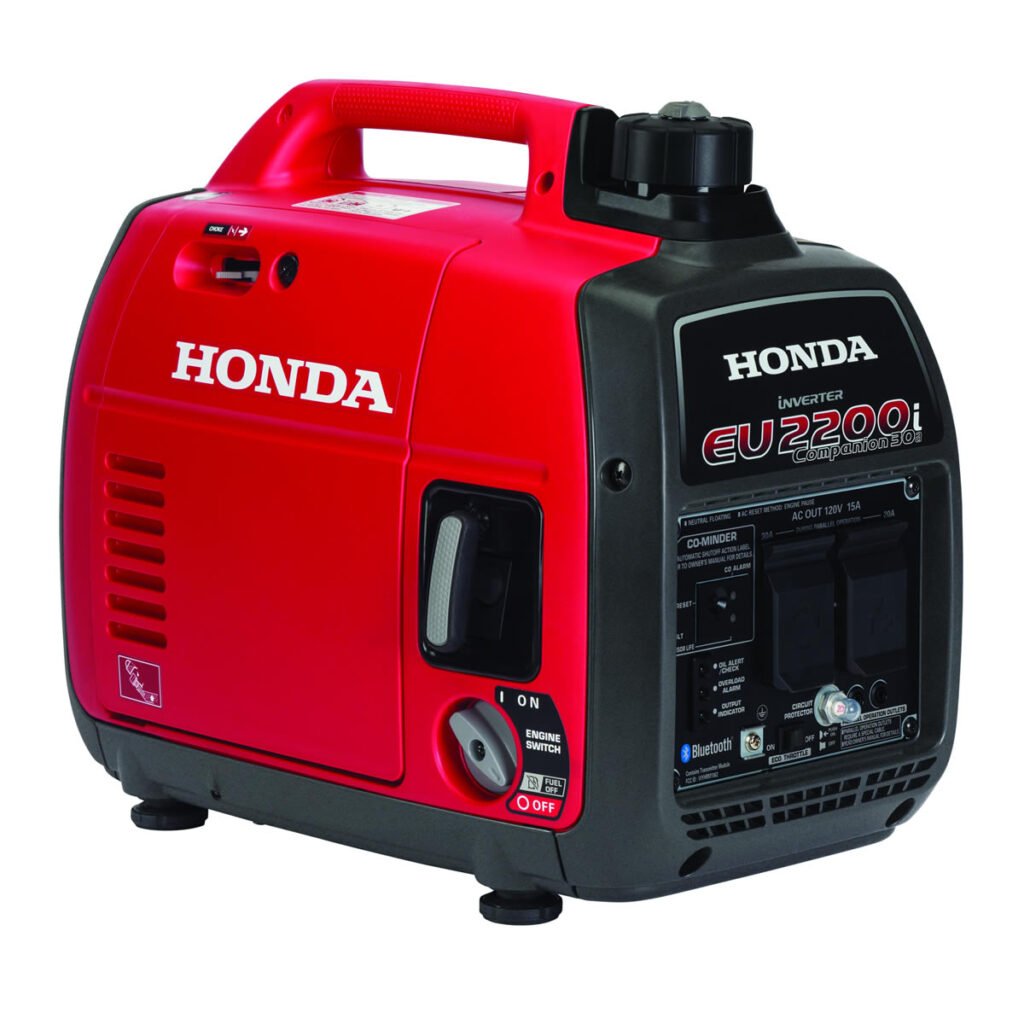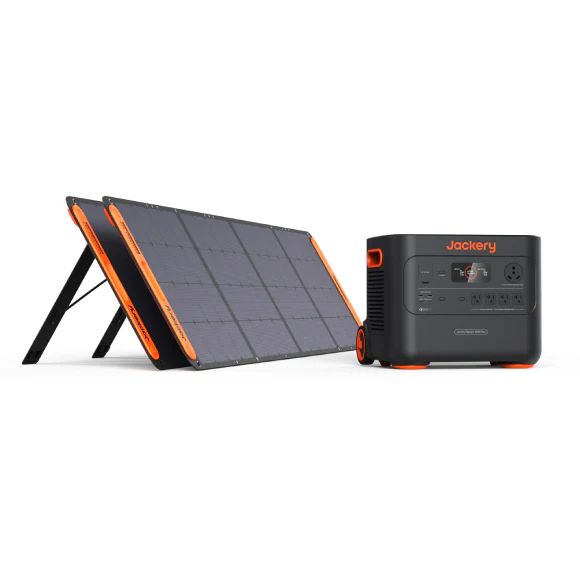With a proliferation of options over recent years, and massive improvements in solar panels and batteries, it’s important to take a look at the portable power station as a possible alternative to a portable gas generator for your travel power and home backup needs. While the new generation of inverter portable gasoline generators are quieter, and more efficient, there is still a whole world of difference between the chugga chugga of a gas generator and the super quiet buzz of a power station. Is solar better than a generator? Does the comfort and streamlined ease-of-use of a solar generator outweigh their premium price? Let’s take a look at relative strengths and weaknesses of Solar generators vs Gas generators.
There are a wide range of manufacturers, and varying output strengths for both Gas Generators and Solar Power Station systems. In order to make a decent apples-to-apples (or at least apples-to-pears) comparison, I chose what I consider two of the most the most well-known and reputable brands, at a output level and form factor that makes sense for glamping, bugging out for preppers, or emergency backup power for the home. For the purposes of this article, I chose the Honda EU2200i portable gas inverter generator, MSRP $1199 (find it on Amazon)

and the Jackery Solar Generator 2000 Plus, (consisting of the Explorer 2000 Plus power station and 2 of the SolarSaga 200W solar panels) MSRP $3099, (find it on Amazon)

both of which have similar power output, form factor and carry weight. Let’s look at the solar vs gas generator pros and cons.
Solar vs Gas Generator Cost:
Winner: Gas ⛽️
For the budget-conscious, there is no denying that the portable Gas Generators are easier to justify. For the price of a similar Solar Battery System, you could buy 2 or sometimes even 3 of the Gas Generators. For comparison, based on our two reference systems, Gas is $0.54 per kW of Peak power, and $0.19-0.33 per kWh or Run capacity, whereas Solar is $0.96/Peak and $1.52/Running. With the left over funds in your disaster preparedness budget, you could invest a lot in other areas. See my post “Top 10 Essential Home Preparedness Items” for some ideas.
Top 10 Essential Home Preparedness Items for ANY Disaster
Note that you will also spend an average of $136 per year on running costs (primarily gas) for the Gas Generator system, but for price paid up front, it still crushes Solar.
Comfort:
Winner: Solar ☀️
Generators are noisy, smelly beasts. They rev up and down with usage, farting out fumes, rumbling like a motorcycle idling in your backyard or campsite, while battery systems are clean, modern, and quiet, and can run equally well in a living room, RV or tent. There’s no gas to get on your hands or oil to drip on your jeans. Carrying them around is about the same (a little heavier) as the gas ones, but they can go places a portable Gas Generator never could. It’s like Mad Max vs Star Trek, and it’s not even close. (ok, I went a little dramatic for effect, and the modern inverter generators are much, much better than the old-style gas generators, but the point still stands.)
For OpSec, (Operational Security) Solar is a winner as well. While the panels are potentially highly visible, the quiet operation and lack of fumes of the Solar Generator vs Gas allows you to win “Prepper Hide and Seek” every time. Try running your hydroponic basement farm on a Gas generator during the Zombie Apocalypse, and see how far that gets you.
Output Capacity:
Winner: Mixed (advantage Gas ⛽️)
My goal is to help you, the reader, figure out what type of generator is right for you. Rather than dive into the differences between Watts and Watt-hours, Peak capacity and Running capacity, I’m going to just give you a quick summary here, with a frame of reference that is more intuitive for a modern human: using a 450 Watt refrigerator as the measuring stick, the Solar generator could run 4.5 fridges simultaneously for about an hour, or only 1 fridge for 4.5 hours, whereas the Gas generator could run 4 fridges simultaneously for 3.5 hours, or just 1 fridge for 8 hours. The Gas wins at total effective output capacity, but there is a minimum practical output for a Gas generator. The Solar generator can run a 65W laptop for 30 hours, under which conditions the Gas generator would still run out after 8 hours.
| Honda EU2200i | Jackery 2000 Plus | |
| Peak Capacity | 2200 W | 3000 W |
| Running Capacity | 1800 W | 2042 W |
| Run-time @ 1800 W | 3.5 h | 1.1 h |
| Run-time @ 450 W | 8 h | 4.5 h |
| Run-time @ 65 W | 8 h | 30 h |

Refueling:
Winner: Mixed
When the gas generator power runs out, it is super easy to fill it back up, pull the cord and get back to business. However, you have to have the gas with you. On the other hand, when the battery power station runs out, your solar panels (which you had to carry with you as well) will take about 6-7 hours to recharge, weather permitting, and if it’s still daylight. However, you can potentially do this dance for weeks or months without ever leaving your campsite, instead of having to go get additional gas after a day or two when your gas can has gone dry. Moreover, in a End-of-the-world circumstance, getting additional gasoline is going to be difficult if not impossible.
Maintenance:
Winner: Solar ☀️
Because of the limited number of moving parts, there is little that can go wrong with a Solar setup, as long as it is well put together, well used, and well protected. The electrochemical wear on the batteries causes them to be the first thing to go, averaging 5-15 years at 80% “near peak” output performance. You can maximize this by not running them to 0, and not recharging them fully to 100%. Gas generators need oil changes every 50-100 hours, periodic air filter cleaning/replacement, and carburator cleaning. Fortunately, many parts of a Gas system are repairable with standard tools, whereas a Solar Battery system like the Jackery is not designed to be repaired by the end user, but still, in the end, Solar portables have a lot less to maintain.
Durability/10y cost:
Winner: Mixed (advantage Gas ⛽️)
When evaluating the lifetime cost of any Generator system, we have to make some usage assumptions, in order to do the math. Lifespan estimates for Gas generators are based on an average of 100 hours of usage per year,
so that is what we’ll use for both. The current generation of Power Station batteries last 5-15 years, or 4000-5000 discharge/recharge cycles.
If you only use it for the estimated 100 hours per year, at ~1h per cycle, (the 1800 Watt output figure we used, which is equivalent to the power needs of a small house without AC) you should hit the 10 year mark with minimal additional costs, so your total 10y value will be the up-front cost of the unit, $3099.
For the portable Gas generator, if you use it for the estimated 100 hours a year, that will require 33.3 gallons of gas, two 12-oz bottles of 10W30 oil, and 1 air filter, for an additional yearly cost of about $136.59. Add in 2 spark plug changes, and your total 10y cost for the Gas generator will be 2569.90. (depending on any changes in the price of gas)
That’s less of a slam dunk than the upfront price difference between the solar vs gas generator, but Gas still squeaks out an advantage here. (though that advantage falls away if your expectation is that you’ll surpass the 100-hour average, using the generator more frequently or for longer)

Conclusion:
Winner: Why not both?
There is honestly not a clear winner in this contest. Both systems have their strengths and weaknesses, and so it really depends on what your expected needs are. If you need consistent medium-to-low power to run electronics you can probably get by with a Solar Battery system, however, if you need medium-high output for a while, (like running a corded drill, table saw, or keeping a fridge running for most of the day) you will need a Gas Generator system.
The clear choice to me, if you can afford it, is to purchase both, use the Solar for daily/regular use, and save the Gas for backup when you are having a snap of bad weather, or when you have short-term higher power needs, like a construction project. If you are price conscious, the Gas system (plus 3 days’ worth of gas for disaster preparedness) is the clear winner, but you should be saving up for a Solar Battery system if you’re serious about keeping your family’s lights (and fridges, and CPAP, and whatever) on for a long while after a grid-down event or after bugging out to the bunker/homestead.



